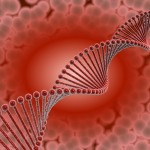Mitosis is a type of cellular division which not only takes place during pregnancy, but also throughout our lives. In mitosis the DNA of each cell (which is normally made up of 46 chromosomes in a human) replicates so that there are 92 chromosomes. Once the DNA has replicated the cell splits into two diploid […]
fetus

Lanugo
Lanugo is a downy hair which covers your baby between week 14 and week 30 of pregnancy and which should be completely shed by week 38. It is a normal part of all pregnancies and is how your baby keeps warm before he begins to develop fat. The fetus usually ends up drinking the shed […]
Ultrasounds
Ultrasounds (a.k.a. obstetric sonography) are a medical technology which use high-frequency sound waves to produce an image of the inside of your body. These images are called sonograms and because they are in real time you can observe movement occurring inside of your body. That means you can see your baby moving! Ultrasounds, like any […]
Fetus
A fetus is the scientific term for your baby after he has completed the embryonic stage and before he is born. In other words your baby is considered a fetus between week 10 and week 40. Unlike the zygotic and embryonic stages of your baby’s development, your fetus actually looks human. Congrats mum and dad […]
Embryo
Between week 3 and week 10 your baby is in the embryonic stage of his development, which means the scientific term for your baby at this time is an embryo. The development of the embryo is known as embryogenesis. The zygote which forms after fertilisation undergoes mitosis for about 5 to 7 days until it […]
Possible complications of multiple births
Multiple births are usually considered high-risk pregnancies, but this doesn’t mean your pregnancy will be unenjoyable. However, we have a compiled a list of the possible complications you may expect so that you can speak with your physician about all of the steps you can take to lower your risks and enjoy a healthy pregnancy. […]
Fraternal twins
Fraternal twins result from a pregnancy in which two eggs are fertilised during conception. Two eggs means that each baby will have its own placenta and its own amniotic sac. This lowers the risks of the possible complications associated with fetuses who share these two important lifelines during pregnancy. Fraternal twins are the most common […]
Triplets and more
Though fraternal twins and identical twins are the most frequently occurring multiple births, triplets, quadruplets and even octuplets are also possibilities. The occurrence of such multiple births have greatly increased with the rise in fertility treatments. Triplets result from pregnancies in which one, two or three eggs are fertilised. This means either one egg is […]
